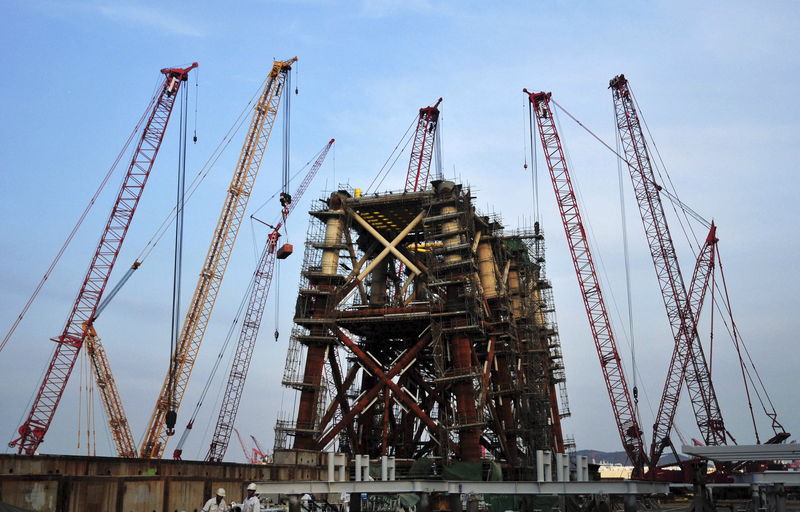[ad_1]
 © Reuters.
© Reuters. By Barani Krishnan
Investing.com — It was in all probability months late in coming. However China has lastly finished what it has been toying with ever for the reason that fertilizer hit the fan on its inflation: slash a few of its dear oil imports by turning to its reserves as a substitute.
It’s an audacious gamble. In making an attempt to manage inflation at residence, Beijing is successfully suppressing the worldwide value of oil; utilizing what it has stockpiled to solely purchase once more from overseas when the value is correct. As the biggest importer of crude, China’s purchases are intently watched as an indicator of demand. If it buys extra, the value will rise and if it buys much less, it is going to drop.
Within the on line casino analogy, what Beijing is doing is betting towards the home, with the “home” on this case being OPEC and its allies. And that is a tricky home to wager towards.
With grains and metals, once you minimize your shopping for, the sellers within the producing nations will sometimes let costs drop sufficient to get your small business again. With the Group of the Petroleum Exporting Nations and its allies, nonetheless, the other is prone to occur. As soon as oil costs begin falling steadily and considerably, the alliance will gang as much as minimize manufacturing, and ship the market again up – usually larger than it had fallen.
How far the Chinese language go at this sport will rely on how a lot tolerance is proven by the 23-nation OPEC+, which includes the 13-member Saudi-led OPEC and its ten oil producing allies steered by Russia.
Since taking again management of the demand-decimated oil market from the peak of the coronavirus pandemic, OPEC+’s unyielding manufacturing cuts have enabled crude costs to commerce at multiples to their 2020 lows. The alliance has solely now began including to output. However it might probably roll them again at a blink ought to China’s stockpile releases show detrimental to the market.
The market motion within the 48 hours after China’s announcement additionally confirmed how fleeting a win may be for the republic.
tumbled virtually 2% proper after the stockpile transfer. However within the subsequent session itself, the market recouped two-thirds of what it misplaced on U.S. provide tightness from Hurricane Ida. The rebound was additionally aided by indicators that Sino-U.S. ties could enhance after a cordial Xi-Biden cellphone name (ironic that whereas China was making an attempt to get crude costs down on one facet, it not directly boosted them one other method).
Anyway, this isn’t about how the market fares someday or the opposite. It’s about whether or not Beijing will be capable of successfully hold oil inflation down. And there are blended views on whether or not it might probably.
Some longtime market commentators, like John Kilduff of New York vitality hedge fund Once more Capital, really feel China’s hand within the scenario is overrated.
“Based mostly on their previous success with metals and different commodities, they suppose they’ve the Midas contact to handle the inflation of their economic system via oil value controls too,” stated Kilduff. “They could have some levers to tug nevertheless it’s by no means going to be too lasting, given the counter-reaction we will anticipate from OPEC+. Over the longer run, China will in all probability discover out the arduous method that it’s arduous to maintain at this.”
China’s Nationwide Meals and Strategic Reserves Administration stated its stockpile launch was “to ease the strain of rising uncooked materials costs.” It stated a “normalized” rotation of crude oil within the state reserves is “an vital method for the reserves to play its function in balancing the market”. The company additionally stated that placing nationwide reserve crude oil in the marketplace via open auctions “will higher stabilize home market provide and demand”.
We get why China is doing this. A few of its factories are already slicing manufacturing from a mixture of surging vitality prices and electrical energy shortages. Manufacturing facility-gate inflation within the No. 2 economic system accelerated in August to a 13-year excessive.
The query, although, is does Beijing have sufficient oil reserves to play the lengthy sport on this?
The final publicly-disclosed determine on China’s so-called SPR, or Strategic Petroleum Reserve, in 2017, was 237.66 million barrels in all.
That considerably aligns with what consultancy Power Elements Ltd estimates for the present Sino reserve: 220 million barrels.
As vital because the reserves is consumption. In accordance with CEIC, one other consultancy, China consumes some 14.2 million barrels per day.
Given its dynamic want for oil, there’s merely no method China can go with out importing oil for too lengthy. Neither ought to we anticipate it to. What China can do as a substitute is a big inventory launch each time the oil market is – or seems to be – overheating. That might be efficient in muting oil value shocks, even when it doesn’t strain them on a regular basis. In that method, China will get what it needs with out triggering OPEC+’s ire.
Some say China may emerge as a brand new destructive power in oil, making the demand outlook extra questionable. From right here on, Beijing can now not be seen as only a cheerleader of commodity supercycles; it can be a silent bear when costs aren’t going its method or hurting its economic system.
“The oil market is in deficit. However this China story may disrupt it (from) staying in deficit for the remainder of the yr,” stated analyst Ed Moya at on-line buying and selling platform OANDA.
Osama Rizvi, vitality analyst at Major Imaginative and prescient Community, says China might be one purpose why oil doesn’t hit $100 a barrel.
“China amassed an enormous quantity of oil when costs hit a 20-year low and as costs proceed to rise, China will probably be more and more incentivized to faucet its reserves quite than import costly oil,” stated Rizvi. “Whereas that is unlikely to alter the underlying fundamentals of oil markets, the discount in Chinese language imports is actually one of many elements that would lastly drive a shift in oil market sentiment.”
Oil/Gasoline Market & Worth Roundup
Oil rose to briefly high $73 a barrel on Friday, supported by rising indicators of provide tightness in the USA because of Hurricane Ida and as U.S.-China commerce hopes gave riskier belongings a lift.
London-traded crude, the worldwide benchmark for oil, settled at $72.92 per barrel, up $1.47, or 2.1%. For the week, Brent rose 0.4%.
New York-traded , the benchmark for U.S. oil, settled at $69.72 per barrel, up $1.58, or 2.3%. For the week, WTI rose 0.6%.
Pure fuel costs, in the meantime, settled down on Friday however nonetheless completed the week up. Most-active on NYMEX’S Henry Hub settled the day down 1.9% at $4.938 per mmBtu, or million metric British thermal models. For the week, the spot fuel contract gained 4.8%, extending the 7.8% achieve from final week and 13.5% from the week prior.
Gasoline costs have been on a tear for the reason that yr started on climate extremities and underwhelming manufacturing. The rally gained additional momentum this month after Hurricane Ida shut down a swathe of fuel manufacturing amenities on the Gulf of Mexico.
For the yr, fuel costs are up 95%, with analysts estimating they might attain $6 per mmBtu subsequent.
Power Markets Calendar Forward
Tuesday, Sept 14
Cushing stock estimates
Wednesday, Sept 15
weekly report on oil stockpiles.
Thursday, Sept 16
EIA weekly report on
EIA weekly report on
EIA weekly report on
EIA weekly report on
Friday, Sept 17
Baker Hughes weekly survey on
Gold Market & Worth Roundup
Gold booked its first weekly loss in 5 as temporary euphoria for longs over the dismal U.S. jobs report for August gave option to dismay because the greenback rebounded on relentless discuss of a Federal Reserve stimulus taper.
on New York’s Comex closed down $7.90, or 0.4%, at $1,792.10 an oz.. For the week, it fell 2.3%, its most for the reason that week to July 29. It was additionally Comex gold’s first weekly loss for the reason that finish of July.
Friday’s drop in gold was partly pressured by information exhibiting US producer costs rising by 8.3 p.c in August, their most in over a decade, as inflationary strain grew unrelentingly in an economic system making an attempt to interrupt out of the shackles of the coronavirus pandemic.
The Fed’s stimulus program and different financial lodging have been blamed for aggravating value pressures in the USA.
The central financial institution has been shopping for $120 billion in bonds and different belongings for the reason that COVID-19 outbreak of March 2020 to help the economic system. It has additionally been protecting rates of interest at nearly zero ranges for the previous 18 months.
The query of when the Fed must taper its stimulus and lift rates of interest has been hotly debated in current months as financial restoration conflicts with a resurgence of the coronavirus’ Delta variant. The argument for a taper was, nonetheless, weakened significantly after US jobs development for August got here in at 70 p.c under economists’ goal.
The greenback initially tumbled on that jobs report, fueling gold’s rally to a four-week excessive of just about $1,837. However virtually instantly after that, the Greenback Index , which pits the greenback towards six main currencies, rebounded, sending gold to a low of simply above $1,783.
After declining 3.5% in 2020 from enterprise shutdowns owing to COVID-19, the US economic system expanded robustly this yr, increasing 6.5% within the second quarter, in keeping with the Federal Reserve’s forecast.
The Fed’s downside, nonetheless, is inflation, which has been outpacing financial development.
The Fed’s most well-liked gauge for inflation – the core Private Consumption Expenditures Index, which excludes risky meals and vitality costs – rose 3.6% within the yr via July, its most since 1991. The PCE Index together with vitality and meals rose 4.2% year-on-year.
The Fed’s personal goal for inflation is 2% each year.
Disclaimer: Barani Krishnan doesn’t maintain a place within the commodities and securities he writes about.
[ad_2]
Source link







